This week my blog features part two of a long review of the 1994 motion picture The Shadow, which also discusses the differences between The Shadow in the movies, the pulp magazines, and on radio. Picking up from last week…
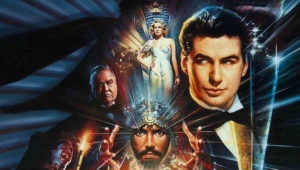 The movie shows us a scene where Shiwan Khan meets with Lamont Cranston in the sanctum. This never happened in any of the four pulp Shiwan-Khan novels; it was strictly created for the movie. The two have a civilized talk before Shiwan Khan leaves The Shadow a special Bronzium coin and disappears.
The movie shows us a scene where Shiwan Khan meets with Lamont Cranston in the sanctum. This never happened in any of the four pulp Shiwan-Khan novels; it was strictly created for the movie. The two have a civilized talk before Shiwan Khan leaves The Shadow a special Bronzium coin and disappears.
I thought it was interesting to note some differences in this scene, compared with the pulp versions of The Shadow’s sanctum visits. For one thing, he appears in the sanctum in his street clothes as Lamont Cranston. In the pulps, he always visited the sanctum in his black cloak and slouch hat.
In the movie, the sanctum is large and well-lit. It looks like a library with shelves of books. In the pulp mysteries, the sanctum was always shrouded in blackness. Only a circle of blue light would shine upon the polished surface of a black desk. Several Shadow pulp stories mentioned some file cabinets in the room, as well as a strange clock with concentric circles instead of hands. But other than that, we had little idea what the sanctum contained. Since that would obviously not translate well to the filmed media, it’s understandable that the sanctum had to be portrayed differently than in the pulps.
In their conversation in the sanctum, Shiwan Khan explains he was also a student of the Tulku in Tibet. This conforms to the pulp version, as well. In the pulps, Shiwan Khan was another student of the Tulku. But then he goes on to talk about Ying Ko, the butcher of Lhasa. This is where the plot diverges from the pulps. In the pulps, the name of Ying Ko was an honored one among the Chinese. In the movie, contrarily, the name of Ying Ko is one of which Cranston is ashamed.
Shiwan Khan also goes on to explain how he had slain the Tulku, before leaving to start creating his own personal empire. In the pulps, that never happened. Shiwan Khan was a student of the Tulku, but never killed him.
Bronzium… ah, Bronzium…
As Shiwan Khan leaves the sanctum, he tosses The Shadow a strange oriental coin. The coin is made of Bronzium, the lost metal of the ancients. This powerful element can be used to create a bomb of fantastic power. And that’s just what Shiwan Khan has in mind. The metal appeared in the third of the Shiwan Khan pulp novels, when Shiwan Khan gave chemist Hiram Selsby a sample of the strange coppery metal as a bribe. Again, the pulp novels continue to influence the film.
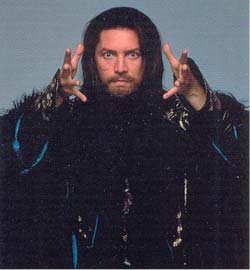
In the next part of the movie, we see Shiwan Khan use his power of telepathy to control his subject from a distance. He takes control of Reinhardt Lane‘s mind remotely. He wants Lane to work on the creation of a bomb, and once under Shiwan Khan’s control Lane will do just that. This fits in well with the pulp stories. In the pulps, Shiwan Khan possesses the same abilities. An innocent person can come under his influence, even though he be far away. The film continues to maintain faithfulness to the original pulp series, here.
Shiwan Khan uses his telepathic powers to put Margo Lane under his control. He sends her to kill The Shadow. She walks into Cranston’s apartment and shoots her pistol at him. Luckily, she’s looking at a mirror reflection, and only ends up shooting a mirror before Cranston can disarm her. But that does bring up an interesting question. Why can Shiwan Khan mentally control Margo when Lamont Cranston can’t? I can only guess that either Cranston really wasn’t trying all that hard at the time, or he failed because his powers hadn’t matured yet. So perhaps at that point, his telepathic control wasn’t as strong as Shiwan Khan’s. Of course, this would change by movie’s end.
But although the movie Cranston can’t control Margo, he can telepathically contact her. In one scene, The Shadow is trapped inside a huge metal tank filling with water. The door is jammed from the outside, and the only way to escape is to have someone on the outside open it. The Shadow makes a mental call to Margo Lane. She hears his telepathic call for help, jumps in her car, and rushes to his rescue. The pulp Shadow had no such powers of telepathy. The radio Shadow, on the other hand, did display such powers on several occasions in the early radio shows. In one of Orson Welles’ 1938 broadcasts “Message From the Hills,” The Shadow was able to transmit his thoughts over many miles distant.
This same scene, in which The Shadow is in peril of drowning, is very reminiscent of the radio broadcast “Society of the Living Dead” where the water was rising as The Shadow was trapped inside an underground vault. In that broadcast, he called for Margo Lane to rescue him as well. But it was apparently a portable short-wave radio set, not telepathy that he used to summon her.
Before The Shadow is trapped inside the metal tank, he is shot by Farley Claymore. Yes, even though he’s invisible, Claymore determines The Shadow’s location by looking for disturbances in the rising water. He can’t see The Shadow, but he can see The Shadow’s movements in the water. This seems to be taken from a radio show where gangsters were able to shoot The Shadow by seeing his splashes in the water.
The Hotel Monoloth
The final confrontation between Shiwan Khan and The Shadow takes place in the Hotel Monolith. This location was taken directly from the second pulp novel in the Shiwan Khan series, “Shiwan Khan Returns.” In the pulp, it was the name of the hotel taken over by Shiwan Khan. In the movie, Shiwan Khan has hypnotized all of New York and made the hotel invisible. All they see is an empty lot. It’s nice to see the writers being faithful to even the small details of the hotel’s name. But they certainly weren’t faithful in having it be invisible. That part was never in the pulps. And in the radio shows, there was never an instance where a building was rendered invisible through mystic powers, either.
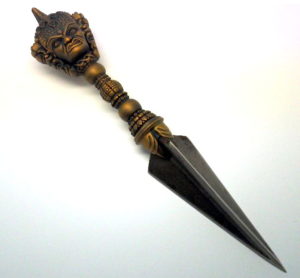
As The Shadow battles Shiwan Khan in his lair, he also fights the phurba, the living bronze dagger. Shiwan Khan controls the dagger with his mystic powers until The Shadow gradually wrests the power away and turns the phurba upon its own master. The phurba is another creation taken from the pulps. It’s featured extensively in the third Shiwan Khan pulp story “The Invincible Shiwan Khan.” However, in the pulp story, it is “reputed” to have living power. It “seemingly” jumps from the hands of its wielder into the body of its victim. It never actually lives, in the pulps; it just seems to. In the movie, however, the writers crossed that boundary and actually made the dagger live.
The final fate of Shiwan Khan in the movie differs from the pulps. In the last of the four pulp novels, Shiwan Khan goes to a gristly death. Hiding in the silver coffin of Genghis Khan, the entire thing is plunged into a burning inferno. Flames hot enough to melt the silver sarcophagus consume Shiwan Khan in his final confrontation with The Shadow. In the movie, however, Shiwan Khan lives at the end. After brain damage and a lobotomy, he no longer has his mystic powers; but he lives. My guess is that this was done in order to allow for his return in future movies. Movies that never happened.
The final scene of Lamont Cranston and Margo Lane has them kissing. Now that’s something strictly from the movies. They never kissed either on radio or in the pulp stories. In the pulps, they were platonic friends. Margo was simply an agent for The Shadow. On the radio, there were a few hints of romance, but nothing ever blatant. Certainly no such kiss. But, hey, it’s a movie!
In a definite nod to the radio series comes this piece of dialogue: “Mr. Claymore’s going to receive a little visit… (pause) …from The Shadow!” That’s exactly the way Lamont Cranston would say it to Margo Lane in oh so many Shadow radio broadcasts. Alec Baldwin got the pause and the inflection just right.
A potpourri of comments…
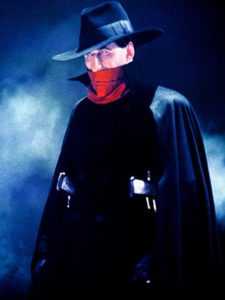
I’d like to make a few final comments about various things that popped up in the film. These are in somewhat random order, but are noteworthy when they either agree or conflict with the pulps. Let’s start with where Lamont Cranston lives. In the pulps, he lives in a New Jersey mansion. In the movie, he lives in a large New York house. Why the difference? It probably made for a tighter movie; less travel time.
In his mansion, Lamont Cranston had a faithful valet named Richards. At least in the pulps. In the movie, there is a butler. He has no lines, and doesn’t appear in the end credits. Margo refers to him as “Resgul” if my hearing was correct. It would have been nice to have his name conform to the pulps, since the writers obviously took such great pains to keep other minor details intact. But, alas, they didn’t.
There is no limousine in this story. In the original pulps, Lamont Cranston often rode around in a limousine, chauffeured by his long-time driver Stanley. In the movie, however, all transportation is provided by Moe Shrevnitz and his taxicab. Again, I suppose this was done to keep the film uncluttered and tighter. But it would have been nice to have seen Stanley, even if briefly.
Another person we don’t get to see is Inspector Joe Cardona. He is referred to at the scene of the museum suicide/murder, as being “over there.” But he’s off-screen and we don’t get to see him. Perhaps the Cardona character actually did appear in the film before trimming. I’d like to think so. I’d rather think that he ended up on the cutting room floor, rather than to have been ignored all-together.
We also don’t get to see many of The Shadow’s agents. We only get to see Moe Shrevnitz, Burbank, Margo Lane, Dr. Roy Tam, and that unnamed policeman/agent who leaves the museum to deliver a message to the “B. Jonas” office. The Shadow mentions his large network of agents to Dr. Tam after the bridge rescue, but we never get to see them. There’s no Harry Vincent, Cliff Marsland, Hawkeye, Clyde Burke, Jericho Druke, Rutledge Mann, Dr. Rupert Sayre, Miles Crofton or Chance LeBrue.
In the film, Margo Lane does make one comment that might refer to Harry Vincent, however. She says that she first realized she had telepathic abilities when, as a child, she could read the mind of her cousin Harry. I’d like to think that is at least a passing homage to Harry Vincent.
Two of the agents, Dr. Tam and Moe Shrevnitz, are married in this movie. That only half agrees with the pulp stories. Dr. Roy Tam did have a family, as mentioned briefly in a couple of the magazine tales. Moe Shrevnitz was single in the pulps, though. Yet in this movie, we get a glimpse of Moe Shrevnitz at home with his wife. In the pulps, agents were rarely married. The only other exception was Cliff Marsland who married the sweetheart he want to jail for. (He was covering for her worthless brother.) But she was only mentioned briefly for several novels, and then was never mentioned again. No other agents had wives. Probably the occupation was just too dangerous!
Another point of interest is that in the film, the only newspaper ever shown or mentioned is the New York World-Telegram. In the pulps, it was always the New York Classic. That’s the paper that reporter Clyde Burke worked for, and the paper that always was used in the novels. Perhaps since Burke wasn’t used in the movie, his newspaper was replaced as well.
In the movie, The Shadow takes a short trip to Chinatown where he meets Shiwan Khan in a Chinatown restaurant. In the pulp stories, The Shadow occasionally visited Chinatown. In fact, the “Chinatown” pulp stories are considered some of The Shadow’s best. On the radio, The Shadow rarely had any Chinatown adventures… just a scene or two in a few episodes. This part of the movie, then, was taken mostly from the pulp magazine stories.
The disappearing — and reappearing — ink
In the pulps, The Shadow always writes in a vivid blue ink that disappears. His agents respond in disappearing ink as well. It was nice to see this in the film version. It behaves rather strangely in the film, however. It seems to disappear shortly after the note is written, then reappears again as the agent reads the note. And disappears again after it is read. There is no heating the message over a flame or burner. It just seems to appear and disappear by itself without any outside aid.
In one scene we see Burbank write a note and use a rubber stamp at the bottom to affix a silhouette of The Shadow as signature, before all the writing disappears. This is also faithful to the pulps, although The Shadow’s silhouette isn’t commonly mentioned. But in several pulp novels we are told that there is a light silhouette of The Shadow on the note, which gradually disappears along with the writing. We aren’t told that it was placed there by a rubber stamp, but that certainly makes sense.
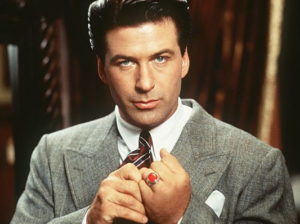
All in all, the 1994 film version of The Shadow is very evocative of The Shadow pulps. The New York of the film is dark and forboding, as was the New York of the pulp stories. The background music, while nothing like Omphale’s Spinning Wheel, the famous radio theme, is still quite good. It gives the mood of adventure and mystery that is most suitable for The Shadow. And the movie even throws in a few references to “the evil that lurks in the heart of men,” “the weed of crime,” and a couple of “The Shadow knows!”
This film is not of pure pulp derivation. And that’s not necessarily bad, because it’s not meant to be read; it’s to be watched. But it relies heavily on the pulp version of the character for its vision. I’d say it’s 75-percent pulp inspired, 15-percent radio inspired, and 10 percent created from neither. I’ve watched this movie four times, and for a person who rarely watches a movie more than once, that’s pretty good. And I plan on watching it again. Yes, The Shadow really does know!
This review of “The Shadow” is taken from my book The Shadow in Review: The Ultimate Guide to the Pulp Magazine Series.
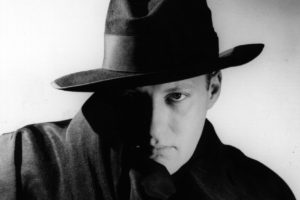


The late Jerry Goldsmith composed the score for “The Shadow”. His oeuvre spanned genres from such epics as “Tora! Tora! Tora!”, “Patton” and “The Wind and The Lion” to those neo-noir classics “Chinatown” and “L.A. Confidential”.
That guy was prolific! From “Star Trek: Next Generation” to “Man from UNCLE” he certainly could produce music.
Another of my favorite composers is James Horner. He caught my attention with Roger Corman’s cheapie sci-fi “Battle Beyond the Stars” and went on to do “Star Trek: Wrath of Khan” among many, many others.
Music makes the movie!
John,
“Don’t be a curmudgeon,” I reminded myself as I read your review of the 1994 film version of the Shadow. After all I did not greatly dislike the film but I also found very little to like about it. “The Shadow”, helmed by director Russell Mulcahy, was an attempt to duplicate the success of Tim Burton’s movies about the Batman, a character that was created in 1939 with many elements taken directly from the Shadow, but the film “The Shadow” commercially and aesthetically fell short of what those Burton Batman films achieved.
When a meal comes out bad, who is to blame, the person who wrote the recipe or the person who cooked the meal, and in this case, who is responsible for the shortcomings of “The Shadow”, the writer or the director? The film was written by David Koepp, who also wrote “Carlito’s Way” ( 1993 ), “Mission Impossible” ( 1996 ), “Spider-Man” ( 2002 ), “Angels & Demons” ( 2006 ), and “Inferno” ( 2016 ) as well as darker fare such as “Secret Window” ( 2004, writer/director, co-written by Stephen King ) and “Suspicious” ( 1994, writer/director, a short film released at the New York Film Festival ) along with several other major theatrical releases. Director Mulcahy brought to “The Shadow” his experience of directing several music videos and five theatrical films: “Highlander” ( 1986 ), “Highlander II ” ( 1991 ), “Ricochet” ( 1991), “Blue Ice” ( 1992 ) and “The Real McCoy” ( 1993 ), and since directing “The Shadow”, he has directed several television movies and episodes of television series as well as “Tale of the Mummy” ( 1998 ), “Resurrection” ( 1999 ), “Swimming Upstream” ( 2002 ), “Resident Evil: Extinction” ( 2007 ) and “Give’em Hell Malone” ( 2009 ).
Your review gave me a key I needed to unlock one of the qualms I had about the film. You wrote, “(i)n the movie, the sanctum is large and well-lit…. In the pulp mysteries, the sanctum was always shrouded in blackness. Only a circle of blue light would shine upon the polished surface of a black desk…. Since that would obviously not translate well to the filmed media, it’s understandable that the sanctum had to be portrayed differently than in the pulps.” No, a director who understood that the Shadow embodied darkness and who had command of the medium could have staged a very effective scene in the Shadow’s sanctum with movement within spots of light punctuated by the spectral laughter.
Walter Gibson acknowledged that when creating the Shadow’s persona he was influenced by Bram Stroker’s Dracula. Steeped in stage magic, Gibson loaded the Shadow with attributes from prestidigitators he knew; from Houdini ideas what a man can do physically; from Thurston motifs of the macabre and spectral and from others slight-of-hand and other feats of the seemingly impossible. The Shadow is a very theatrical character, especially if the proper atmosphere is created.
Tim Burton has been very successful taking fantastic elements and treating them very realistically while respecting the original conceit of the fantasy ( e.g. “Batman”, “Edward Scissorhands”, “Corpse Bride” et al. ). When given the dilemma of how to present the fantastic, director Russell Mulcahy and producers of “The Shadow”, with the Diocletian sword of a big budget over their head, felt safer to ridicule it. The result was a major motion picture with a top-echelon cast that would have been suited to the b-picture slot in a double-feature billing.
The concept of “rebooting” a film or film series seems to have gotten more and more popular in recent years. It seems that even in cases where ten years has passed (or even less) a film can get rebooted. Maybe it’s time for The Shadow! Hey, it’s been 22 years, so it certainly would qualify.
A competent producer and director could create a new Shadow film that might address some of the shortcomings you indicate above. Wouldn’t it be wonderful to see a more authentic version! I hate to see The Shadow fading from public memory. He deserves better.